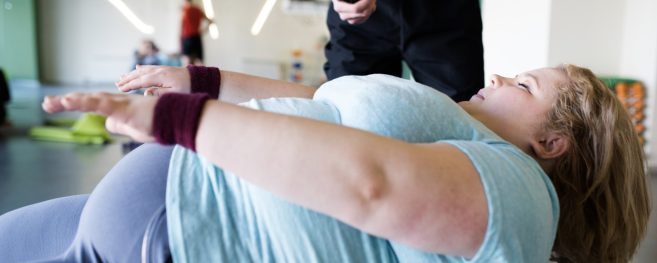Exercise for Weight Loss Success after Bariatric Surgery
It would be nice if people could eat or drink anything, remain sedentary and still manage to stay healthy. Unfortunately, this utopian world doesn’t exist and in fact we live in an obesogenic society were we must eat healthy and exercise to stay healthy. My interest as a bariatric surgeon and avid weekend runner is to help people maintain long term weight loss by encouraging and supporting patients to get involved in post-bariatric surgery exercise. This can be achieved by developing a positive exercise behavior while slowly introducing physical activity that promotes cardio-respiratory fitness, flexibility and strength.
People are consuming foods high in carbohydrates and refined sugars more than ever while staying inactive and falling victim to the obesity epidemic. In the U.S., more than one third of Americans are now considered obese, 17 million or approximately 4.7% of the US population is morbidly obese and about 18 million people also suffer from diabetes. The National Institute of Health (NIH) in 1992 concluded that bariatric surgery along with a healthy diet, regular exercise and behavior modification is the most effective treatment for severe obesity. Since then, many studies have proven the safety and benefit of bariatric or weight loss surgery. The surgeries that we perform at Tri-State Bariatrics include Lap-Band, gastric bypass and sleeve gastrectomy. These procedures can help people lose weight and live healthier lives by reversing life threatening illnesses such as diabetes, hypertension, sleep apnea and metabolic syndrome. These surgeries are extremely effective in decreasing calorie intake by restricting food portions. The Gastric bypass and sleeve gastrectomy can also balance the hormones that help control hunger including ghrelin and leptin. After the surgeries, usually within 12 to 24 months, a person can lose 50 to 100 pounds and even more depending on their amount of excess weight. During this weight loss period, most patients are very committed and motivated to eating healthier. They modify their eating behavior and usually are following the recommended post surgery diet. But many patients are not
as positive about exercising. Since bariatric surgery is not a cure but only a tool to help fight a disease, some patients are regaining the weight after 2 years of successful weight loss and some even earlier. The reason for regaining the weight may due to many factors but one very important factor is limited or lack of physical exercise. According to a Meta-analysis published in the Obesity Surgery journal, exercise following bariatric surgery appears to be associated with a greater weight loss of over 4% of body mass index (BMI) loss. (1) The patients that are getting the most benefit from weight loss surgery are the ones eating healthy and staying physically active.
A positive exercise behavior is important for maintaining successful long term weight loss. But, it is difficult to be motivated to exercise when a person suffers from obesity and has failed to lose weight in the past or had a negative embarrassing experience while exercising. Other associated illnesses such as severe arthritis, asthma, depression and morbid obesity itself may contribute to the negative exercise behavior. However, the difference after having bariatric surgery is that now you have an effective tool that will help you lose weight. So, it’s important to develop the determination to excise early while you lose weight to prevent regaining the weight in the future. Just realize that we all have the capacity to exercise. Take for example the New York marathon. More than 46,000 people from all ages, sex and physical ability ran the 2011 ING New York Marathon and crossed the finish line. The physiology of our body including -cardiovascular, respiratory and musculature systems- is the same but we all have different fitness levels. However, the psychological determination and motivation is different for everyone and must be improved slowly as we start getting involved in exercise activities. This is even more important for patients who had Lap-band surgery. Lap-band patients who are not exercising have a higher risk of Lap-band failure compared to the patients that are exercising. (2)
Every person has the ability to exercise. But you don’t have to run marathons, triathlons, or Ironman races to stay healthy, although, it would be fantastic if you do. All you have to do is participate in any activity that you are comfortable doing and continue to build on your progress. Any activity can help including walking, dancing, cycling, jogging, swimming, or yoga. The physical exercise you choose should include are aerobic, flexibility and strength. The benefits to your body include:
- Aerobic activity allows the body to increase oxygen delivery to the heart, lungs and muscles while burning excess body fat. This allows your body to increase oxygen delivery and improve endurance that can help you advance to more intense activity such as jogging or cycling.
- Flexibility is important to stretch your muscle fibers, ligaments and tendons in preparation for the activity which can help you prevent injuries.
- Strengthening activity such as calisthenics, resistance or light weight lifting can help you burn excess body fat and build lean muscle.
When all three of these exercise components are incorporated on a regular basis they provide the building blocks to sustain long term weight loss. Exercise will also benefit your body in the following ways:
- Promotes cardiac endurance which may reduce mortality from cardiovascular disease such as heart attacks.
- Increases metabolism allowing your body to burn glycogen and fat the main forms of energy storage in our body.
- Improves glycemic control which is important for patients that are diabetic or pre-diabetic.
- Increase self-esteem and improve depression.
Most experts recommend 30 to 60 minutes of exercise at least three times per week. My recommendation is to exercise for 60 minutes five days a week depending on your initial fitness level. The idea is to slowly improve your motivation, and exercise behavior as your physical fitness level improves. The goal is to burn an additional 3500 Kcal per week or one pound per week. This may be achieved initially by slowly walking to reach an average of about 10,000 to15,000 steps per day (a sedentary person may only average 2500 steps per day). A pedometer is a simple tool that can help track your steps and increase motivation as your weight loss improves. I also use a stop watch to track how much time I spend exercising on a daily or weekly basis.
List of Activity & Calories Burned
| Activity | Minutes | Duration | Calories Burned per Week(5 days) |
|---|---|---|---|
| Biking | 30 | 256 | 1280 |
| Calisthenics | 30 | 255 | 1275 |
| Dancing | 30 | 200 | 1000 |
| Elliptical | 30 | 245 | 1225 |
| Jogging | 30 | 260 | 1300 |
| Swimming | 30 | 230 | 1150 |
| Rowing | 30 | 230 | 1150 |
| Walking | 30 | 97 | 485 |
| Weight Lifting | 30 | 100 | 500 |
| Yoga | 30 | 80.5 | 402.5 |
Conclusion:Physical activity is important for everyone and especially for anyone interested in maintaining weight loss after bariatric surgery. As you start your journey to lose weight, discuss your options with your health care provider. Identify and work to eliminate any obstacles, such as lack of motivation, feeling self-conscious or health concerns that may be preventing you from exercising. Also develop an exercise plan that includes cardio, flexibility and strength to meet your fitness level. A physical therapist or physical trainer may be able to assist with the initial phase of your exercise plan. Getting motivated to exercise is not easy but once you start exercising your one step closer to achieving long term weight loss success.
Reference:
1- Masha Livhits & Cheryl Mercado & Irina Yermilov & Janak A. Parikh & Erik Dutson & Amir Mehran & Clifford Y. Ko & Melinda Maggard Gibbons. ” Exercise Following Bariatric Surgery: Systematic Review. Obes Surg 2010; 20:657-665
2- Jean, Chevallier, MD, PhD,Marie-Helene Rodde-Dunet, MD, Michael Marty, MD, Fracois Nogues, MD, Karem Slim, MD and Arnaud Basdevant, MD, PhD. “Predictive Factors of Outcomes After Gastric Banding. A National Survey on the Role of Center Activity and Patients’ Behavior Ann Surg 2007; 246: 1034-1039











